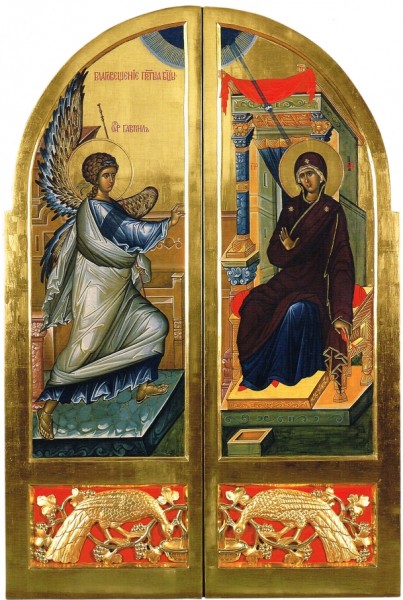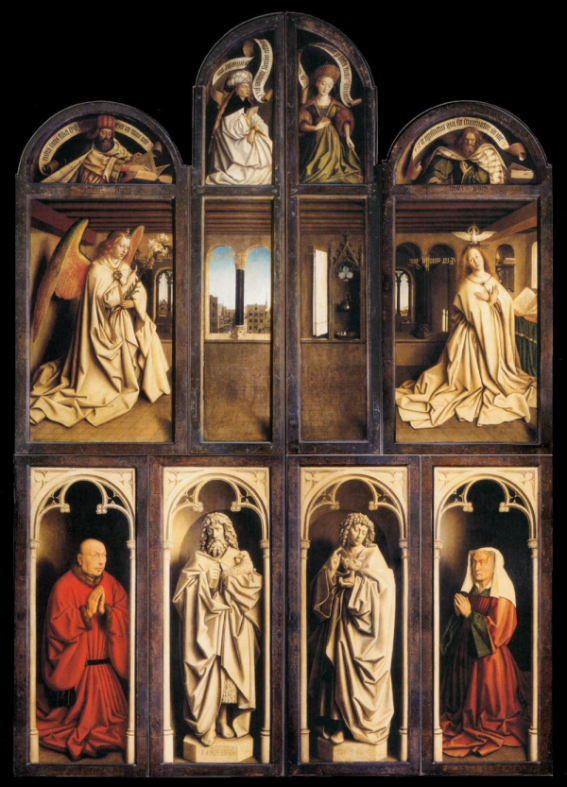This is the third in a series of six, to see the article in full go here…
2. The texts of the liturgy
As I write this I have just returned from a short visit to the Norbertine Canons Regular at St Michael’s Abbey in Orange County, CA. I was talking about this topic with them and one of their seminarians made the point that the Roman Canon ought to be a crucial. I realised that this is the text, perhaps more than any other, that will characterize the Roman liturgy and will contribute its distinctive imagery, differentiating it from other Rites. The saints and the particular OT archetypes referred to in the text could be portrayed pictorially. For example here is a 6th century mosaic of the three sacrifices, Abel, Melchizadek and Abraham which is at Sant’Apollinare in Classe in Ravenna.
3. The Eastern Rite.
I suggest that the schema for iconostases should be studied in such a way that we can understand how they are formed by the liturgy. I would be looking at the images contained and also their relative positions so that it enables the worshippers to interract with saints portrayed and be engaged with the mysteries represented.
To take just one example that was pointed out to me recently by Melkite priest, Fr Sebastian Carnazzo of St Elias Melkite Catholic Church: at the centre of the iconostasis are the Royal Doors which are opened periodically during the Divine Liturgy. On these will be, typically, icons that show the Annunciation.
By this Mary, the Mother of God becomes the portal, so to speak through which the Word is made flesh. The image above is a modern example which is at a church in St Petersburg, and which is based on a 14th century Greek image (with the addition of peacocks which symbolize eternal life). When the doors are opened, we see the altar and so the two are connected in our minds. I found the image below of Holy Ressurection Melkite Catholic Church in Columbus, Ohio. The large image of the Mother of God, now behind the altar reinforces the point that her Son is between us. There is no image of the Easter Resurrection itself, the Ressurected Christ is visible however, and is seen with the eyes of Faith on the altar.
4. Study the Western tradition in the light of what we learn.
In parallel with this study we should look at examples of schema of the West, where they exist, and look for similarities and differences and try to account for them. Consider now, for example, the Ghent altarpiece from the 15th century. This is a reredos and so in contrast to the above, it would have been situated behind the altar and not in front of it.
Nevertheless there are similarities. It too has doors. When closed it looks like this:
So we see that here too the Annunciation is the dominating image. As well as the prophets and patrons, there are St John the Baptist who saw proclaimed the Lamb of God and St John the Evangelist who described the moment in his gospel.
When the doors of the reredos are opened then this is the scene is revealed
Just as with the iconostasis the doors open to reveal the altar with the lamb, except this is presented pictorially so as to highlight what is happening in front of it, on the altar in the church. We now see Our Lady as the Queen Mother and John the Baptist flanking Christ in Glory, who is the ‘image of the Father’. For a more detailed analysis of this you can see my article on the Ghent altarpiece in the Adoremus Bulletin of March 2016. Incidentally, notice how, top left and top right we have the sacrfice by and the killing of Abel, in monochrome.
Two of the Marian anthems sung after Compline, for Advent (and Christmas to Epiphany) and Lent, the seasons of anticipation of the coming of the Lord and of his Resurrection speak directly of Mary as the doorway – the door of morning, and heaven’s gateway. I wonder if this connection was made with this painting by the congregations of 15th century Ghent?
The reredos will not have been the only set of images in the church. Most likely a rood screen was in front of the altar and that will have had the crucifixion. This highlights one difficulty of studying past schema – paintings are moved or destroyed and so we don’t know what was there originally. Mosaics might be the best indication we have. We know only too well today, that churches are constantly re-ordered and if you look at many it will very likely offer an assortment of art which reflects the favorite devotions and taste of the last pastor or patron and will not be an indication of tradition.
Continued tomorrow….



